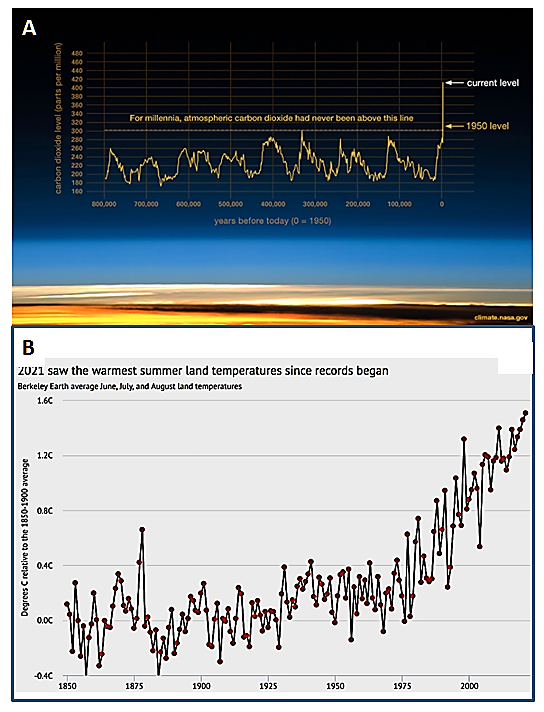by Andrew Glikson
 |
| Figure 1. A. Mean global CO₂ levels from 800,000 years to the present (NASA). B. Mean global temperature rise from 1850 to 2021 (Berkeley Earth). |
As stated by CarbonBrief: “The year so far has been one of extremes, featuring record-shattering heatwaves, wildfires and flooding, as well as the warmest-ever northern-hemisphere summer – June, July and August – in the global land-surface record.”
Whereas climate negotiations mostly focus on possible reductions in emissions, the cumulative buildup of greenhouse gases is determining the future of the terrestrial climate. According to NASA “Once it’s (CO₂) added to the atmosphere, it hangs around, for a long time: between 300 to 1,000 years".
Other estimates are much longer. Because of the longevity of CO₂ and other greenhouses gases in the atmosphere, a decrease in carbon emissions, while essential, is not sufficient to reduce CO₂ levels in the atmosphere in time.
According to the IPCC “about 50% of a CO₂ increase will be removed from the atmosphere within 30 years, and a further 30% will be removed within a few centuries. The remaining 20% may stay in the atmosphere for many thousands of years”. According to the US EPA (Environmental Protection Agency) “Atmospheric lifetime: 50-200 years. No single lifetime can be defined for CO₂ because of the different rates of uptake by different removal processes”.
According to Solomon et al. (2009) and Eby et al. (2009) high levels of CO₂ on the scale of 10² to 10³ ppm would persist for millennia.
Global emission reductions, decreased in part due to COVID-19 economic slow-down, have little effect on the atmospheric CO₂ level, as indicated by the current trend of atmospheric carbon dioxide, at record high levels despite reduced emissions in 2020 (Figure 2). This suggests to a significant extent the current rise in atmospheric CO₂ arises from amplifying feedbacks from land and ocean.
All taking place notwithstanding hollow promises made at COP26, a meeting noted for the near-absence of contributions by climate scientists.
In trying to avoid an exponential rise in greenhouse gases toward catastrophic levels, one option exists, namely urgent attempts at drawing down at least part of the CO₂ concentration of the atmosphere. The $trillions of dollars required, constituting the “Price of the Earth”, may not exceed the $trillion dollars military expenses spent by the world over the last 70 years, including nuclear missile fleets which constitute a separate threat for life on Earth, as warned by Albert Einstein: “The unleashed power of the atom has changed everything save our modes of thinking and we thus drift toward unparalleled catastrophe”.
 |
| Andrew Glikson |
Earth and Paleo-climate scientist
School of Biological, Earth and Environmental Sciences
The University of New South Wales,
Kensington NSW 2052 Australia
The Asteroid Impact Connection of Planetary Evolution
https://www.springer.com/gp/book/9789400763272
The Archaean: Geological and Geochemical Windows into the Early Earth
https://www.springer.com/gp/book/9783319079073
Climate, Fire and Human Evolution: The Deep Time Dimensions of the Anthropocene
https://www.springer.com/gp/book/9783319225111
The Plutocene: Blueprints for a Post-Anthropocene Greenhouse Earth
https://www.springer.com/gp/book/9783319572369
Evolution of the Atmosphere, Fire and the Anthropocene Climate Event Horizon
https://www.springer.com/gp/book/9789400773318
From Stars to Brains: Milestones in the Planetary Evolution of Life and Intelligence
https://www.springer.com/us/book/9783030106027
Asteroids Impacts, Crustal Evolution and Related Mineral Systems with Special Reference to Australia
https://www.springer.com/us/book/9783319745442
The Event Horizon: Homo Prometheus and the Climate Catastrophe
https://www.springer.com/gp/book/9783030547332
The Fatal Species: From Warlike Primates to Planetary Mass Extinction
https://www.springer.com/gp/book/9783030754679



